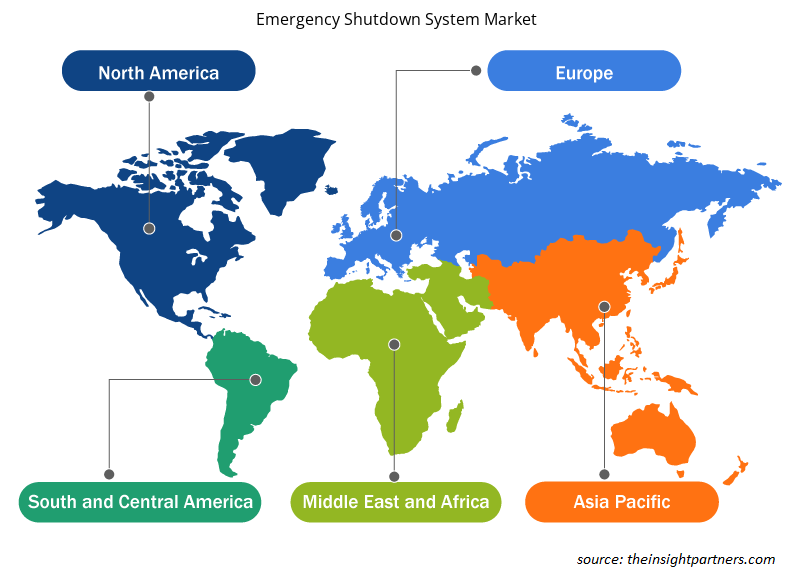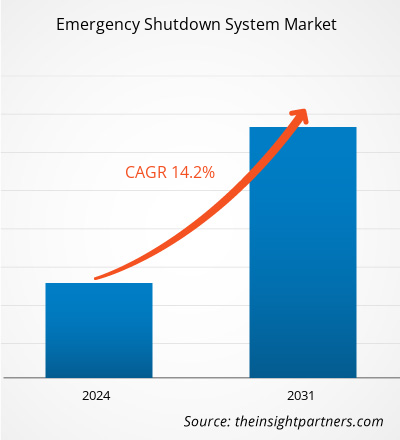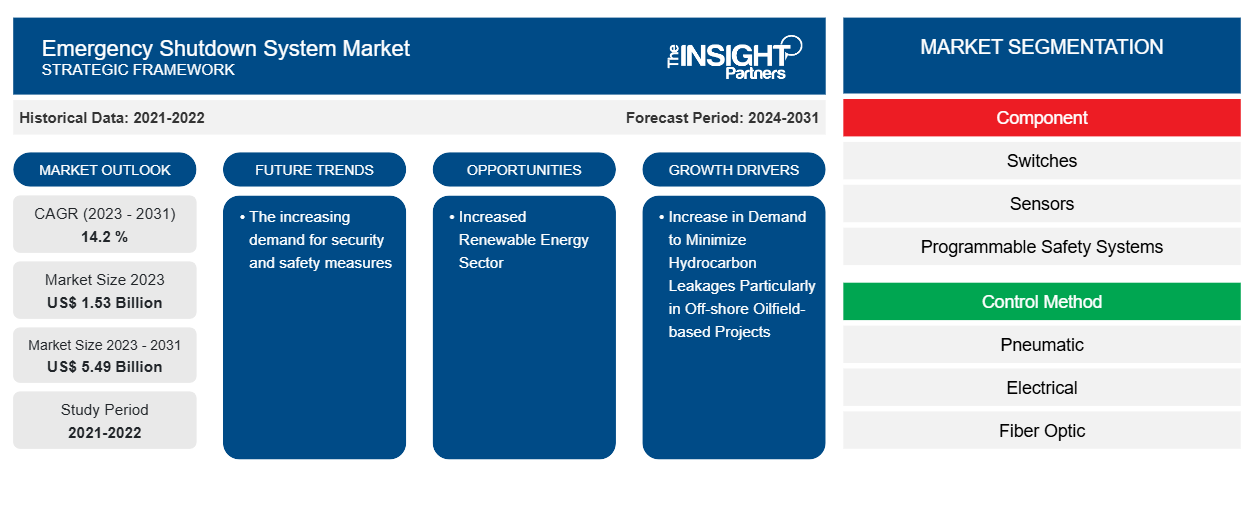من المتوقع أن يصل حجم سوق أنظمة الإغلاق في حالات الطوارئ إلى 5.49 مليار دولار أمريكي بحلول عام 2031 من 1.53 مليار دولار أمريكي في عام 2023. ومن المتوقع أن يسجل السوق معدل نمو سنوي مركب بنسبة 14.2٪ في الفترة 2023-2031. ومن المرجح أن يظل الطلب المتزايد على تدابير السلامة والأمن اتجاهًا رئيسيًا في سوق أنظمة الإغلاق في حالات الطوارئ.
تحليل سوق نظام الإغلاق الطارئ
يتأثر نظام الإغلاق في حالات الطوارئ بشكل كبير بالحضور القوي للمؤسسات الكبيرة عبر مختلف القطاعات الصناعية للمستخدم النهائي نظرًا لعملياتها الصناعية الكبيرة بشكل كبير والمجهزة بحلول تكنولوجية مختلفة.
نظرة عامة على سوق أنظمة الإغلاق في حالات الطوارئ
يتم استخدام نظام يُعرف باسم نظام الإغلاق الطارئ، أو ESD، في البيئات الخطرة لتجنب السيناريوهات التي قد يكون لها عواقب وخيمة على الاقتصاد أو البيئة أو العمليات. من خلال منع أشياء مثل التسربات وتسرب الهيدروكربون واندلاع الحرائق والانفجارات، يتم تصنيعها لتقليل آثار الظروف الطارئة، مثل إلحاق الضرر بالأشخاص أو تدمير المعدات. تشمل الغلايات ومحطات الطاقة التي تعمل بالغاز والبخار ومرافق معالجة النفط والغاز وحقول النفط (رؤوس الآبار النفطية) آليات الإغلاق الطارئ.
قم بتخصيص هذا التقرير ليناسب متطلباتك
ستحصل على تخصيص لأي تقرير - مجانًا - بما في ذلك أجزاء من هذا التقرير، أو تحليل على مستوى الدولة، وحزمة بيانات Excel، بالإضافة إلى الاستفادة من العروض والخصومات الرائعة للشركات الناشئة والجامعات
-
احصل على أهم اتجاهات السوق الرئيسية لهذا التقرير.ستتضمن هذه العينة المجانية تحليلاً للبيانات، بدءًا من اتجاهات السوق وحتى التقديرات والتوقعات.
محركات وفرص سوق نظام الإغلاق الطارئ
زيادة الطلب لتقليل تسربات الهيدروكربونات، وخاصة في المشاريع القائمة على حقول النفط البحرية
الغرض من نظام الإغلاق الطارئ هو تقليل آثار المواقف المرتبطة عمومًا بالفيضانات غير المنضبطة، أو تسرب الهيدروكربونات، أو اندلاع الحرائق في الصناعات الخطرة أو المواقع التي توجد بها الهيدروكربونات . تاريخيًا، أظهر تحليل المخاطر أن برنامج الإغلاق الطارئ يحتاج إلى درجة سلامة عالية (SIL 2 أو 3). تشكل منطق الجهاز لمعالجة الإشارات الواردة، وأجهزة الاستشعار المثبتة في الحقل، والصمامات، ومرحلات الرحلة، والتحذيرات، ووحدات واجهة الآلة البشرية (HMI) غالبية النظام. يتبع الجهاز مخططات السبب والنتيجة التي تم إنشاؤها للتثبيت عند معالجة إشارات الإدخال وتشغيل المخرجات. من المتوقع أن يؤدي نمو العمليات في المنبع وارتفاع أسعار النفط والغاز إلى زيادة الطلب على أنظمة الإغلاق الطارئ (ESDs)، وخاصة من المنشآت البحرية. تعد أنشطة مصافي النفط في منتصف المنبع والمصب والمصب المصادر الأساسية للطلب على أنظمة الإغلاق الطارئ. تخضع أعمال النفط والغاز البحرية في الولايات المتحدة وأوروبا لقيود السلامة والبيئة التي تفرضها القوانين واللوائح مثل مكتب السلامة وإنفاذ البيئة (BSEE). ويتم إجراء مراقبة دقيقة لدرجة الحرارة والضغط لتقليل احتمالية وقوع الحوادث أو الحوادث.
زيادة قطاع الطاقة المتجددة
يشهد قطاع الطاقة المتجددة نمواً ملحوظاً على مستوى العالم. ووفقاً لتقرير الأمم المتحدة، فإن مصادر الطاقة المتجددة متاحة في كل دولة، ولكن إمكاناتها لم تُستغل بالكامل بعد. وتشير تقديرات الوكالة الدولية للطاقة المتجددة (IRENA) إلى أن 90% من كهرباء العالم يمكن وينبغي أن تأتي من الطاقة المتجددة بحلول عام 2050. وتوفر مصادر الطاقة المتجددة وسيلة للهروب من الاعتماد على الواردات، وتنويع الاقتصادات الوطنية، وحمايتها من تقلبات أسعار الوقود الأحفوري، وتعزيز النمو الاقتصادي الشامل، وخلق فرص العمل، والحد من الفقر. وتُستخدم أنظمة الإغلاق في حالات الطوارئ في هذا القطاع لتوفير عمليات آمنة. وفي حالة حدوث ظروف خطرة، يجب اتخاذ إجراءات فورية. ويُستخدم نظام الإغلاق في حالات الطوارئ لإغلاق المنشأة إلى حالة آمنة وحماية البيئة والأصول.
تقرير تحليلي لتجزئة سوق أنظمة الإغلاق في حالات الطوارئ
القطاعات الرئيسية التي ساهمت في اشتقاق تحليل سوق نظام الإغلاق في حالات الطوارئ هي صناعة المكونات وطريقة التحكم والمستخدم النهائي (النفط والغاز والتكرير وتوليد الطاقة والمواد الكيميائية وغيرها)
- بناءً على المكونات، يتم تقسيم سوق أنظمة الإغلاق في حالات الطوارئ إلى مفاتيح وأجهزة استشعار وأنظمة أمان قابلة للبرمجة وصمامات أمان ومشغلات وغيرها. احتل قطاع أجهزة الاستشعار حصة سوقية أكبر في عام 2023.
- بحسب طريقة التحكم، يتم تقسيم السوق إلى هوائي، وكهربائي، وألياف بصرية، وهيدروليكي.
- بحسب صناعة المستخدم النهائي، يتم تقسيم السوق إلى النفط والغاز، وتوليد الطاقة، والتكرير، والمواد الكيميائية، وغيرها.
تحليل حصة سوق أنظمة الإغلاق في حالات الطوارئ حسب المنطقة الجغرافية
ينقسم النطاق الجغرافي لتقرير سوق نظام الإغلاق في حالات الطوارئ بشكل أساسي إلى خمس مناطق: أمريكا الشمالية، وآسيا والمحيط الهادئ، وأوروبا، والشرق الأوسط وأفريقيا، وأمريكا الجنوبية/أمريكا الجنوبية والوسطى. من حيث الإيرادات، استحوذت منطقة آسيا والمحيط الهادئ على أكبر حصة سوقية لنظام الإغلاق في حالات الطوارئ. وقد عزت منطقة آسيا والمحيط الهادئ، بسبب الوجود القوي للمستخدمين النهائيين الصغار والمتوسطين غير المنظمين إلى جانب التنظيم الحكومي المحدود، انخفاض حصة المنطقة في السوق على الرغم من الوجود القوي لقاعدة المستخدمين النهائيين في المنطقة.APAC accounted for the largest emergency shutdown system market share. The APAC region, owing to the strong presence of unorganized small and medium end-users along with limited government regulation, has attributed the region’s low market share despite the strong presence of an end-user base in the region.
أخبار سوق أنظمة الإغلاق الطارئ والتطورات الأخيرة
يتم تقييم سوق نظام الإغلاق في حالات الطوارئ من خلال جمع البيانات النوعية والكمية بعد البحث الأولي والثانوي، والذي يتضمن منشورات الشركات المهمة وبيانات الجمعيات وقواعد البيانات. فيما يلي قائمة بالتطورات في سوق اضطرابات الكلام واللغة والاستراتيجيات:
- في مارس 2023، أصدرت هيئة التحقيق في السلامة الكيميائية والمخاطر الأمريكية (CSB) تنبيهًا جديدًا للسلامة بعنوان "المخاطر التي تشكلها التفريغات من أنظمة تخفيف الضغط في حالات الطوارئ". يسلط تنبيه CSB الضوء على المخاطر التي تم تحديدها في أنظمة تخفيف الضغط في حالات الطوارئ من خلال أربعة تحقيقات أجرتها CSB. تنصح التنبيهات المنشآت بأنه في حين أن التفريغ من أنظمة تخفيف الضغط في حالات الطوارئ يمكن أن يساعد في حماية المعدات من أحداث الضغط العالي غير المتوقعة وغير المرغوب فيها، إلا أنه يمكن أن يتسبب أيضًا في إلحاق ضرر خطير أو إصابة العمال بجروح قاتلة ويسبب أضرارًا جسيمة للمنشأة إذا لم يتم التفريغ في مكان آمن. (المصدر: هيئة السلامة الكيميائية الأمريكية، بيان صحفي)CSB) issued a new Safety Alert titled “Hazards Posed by Discharges from Emergency Pressure-Relief Systems.” The CSB’s alert highlights hazards identified with emergency pressure-relief systems from four CSB investigations. The alert advises facilities that while a discharge from emergency pressure-relief systems can help protect equipment from unexpected and undesired high-pressure events, it can also seriously harm or fatally injured workers and cause extensive damage to a facility if the discharge is not made to a safe location. (Source: U.S. Chemical Safety Board, Press Release)
تقرير سوق أنظمة الإغلاق في حالات الطوارئ - التغطية والنتائج المتوقعة
يقدم تقرير "حجم سوق نظام الإغلاق في حالات الطوارئ والتوقعات (2023-2031)" تحليلاً مفصلاً للسوق يغطي المجالات التالية:
- حجم السوق والتوقعات على المستويات العالمية والإقليمية والوطنية لجميع قطاعات السوق الرئيسية التي يغطيها النطاق
- ديناميكيات السوق مثل المحركات والقيود والفرص الرئيسية
- الاتجاهات المستقبلية الرئيسية
- تحليل مفصل لقوى PEST/Porter الخمس وSWOT
- تحليل السوق العالمي والإقليمي الذي يغطي اتجاهات السوق الرئيسية واللاعبين الرئيسيين واللوائح والتطورات الأخيرة في السوق
- تحليل المشهد الصناعي والمنافسة الذي يغطي تركيز السوق، وتحليل خريطة الحرارة، واللاعبين البارزين، والتطورات الأخيرة
- ملفات تعريف الشركة التفصيلية
نطاق التقرير
رؤى إقليمية حول سوق أنظمة الإغلاق في حالات الطوارئ
لقد قام المحللون في Insight Partners بشرح الاتجاهات والعوامل الإقليمية المؤثرة على سوق نظام الإغلاق الطارئ طوال فترة التنبؤ بشكل شامل. يناقش هذا القسم أيضًا قطاعات سوق نظام الإغلاق الطارئ والجغرافيا في جميع أنحاء أمريكا الشمالية وأوروبا ومنطقة آسيا والمحيط الهادئ والشرق الأوسط وأفريقيا وأمريكا الجنوبية والوسطى.

- احصل على البيانات الإقليمية المحددة لسوق نظام الإغلاق في حالات الطوارئ
نطاق تقرير سوق نظام الإغلاق في حالات الطوارئ
| سمة التقرير | تفاصيل |
|---|---|
| حجم السوق في عام 2023 | 1.53 مليار دولار أمريكي |
| حجم السوق بحلول عام 2031 | 5.49 مليار دولار أمريكي |
| معدل النمو السنوي المركب العالمي (2023 - 2031) | 14.2% |
| البيانات التاريخية | 2021-2022 |
| فترة التنبؤ | 2024-2031 |
| القطاعات المغطاة |
حسب المكون
|
| المناطق والدول المغطاة |
أمريكا الشمالية
|
| قادة السوق وملفات تعريف الشركات الرئيسية |
|
كثافة اللاعبين في السوق: فهم تأثيرها على ديناميكيات الأعمال
يشهد سوق أنظمة الإغلاق الطارئ نموًا سريعًا، مدفوعًا بالطلب المتزايد من المستخدم النهائي بسبب عوامل مثل تفضيلات المستهلكين المتطورة والتقدم التكنولوجي والوعي الأكبر بفوائد المنتج. ومع ارتفاع الطلب، تعمل الشركات على توسيع عروضها والابتكار لتلبية احتياجات المستهلكين والاستفادة من الاتجاهات الناشئة، مما يؤدي إلى زيادة نمو السوق.
تشير كثافة اللاعبين في السوق إلى توزيع الشركات أو المؤسسات العاملة في سوق أو صناعة معينة. وهي تشير إلى عدد المنافسين (اللاعبين في السوق) الموجودين في مساحة سوق معينة نسبة إلى حجمها أو قيمتها السوقية الإجمالية.
الشركات الرئيسية العاملة في سوق نظام الإغلاق في حالات الطوارئ هي:
- شركة أيه بي بي المحدودة
- شركة كاميرون الدولية
- شركة إيمرسون الكهربائية
- شركة جنرال الكتريك
- شركة هونيويل الدولية
- شركة ناشونال أويلويل فاركو المحدودة
إخلاء المسؤولية : الشركات المذكورة أعلاه ليست مرتبة بأي ترتيب معين.

- احصل على نظرة عامة على أهم اللاعبين الرئيسيين في سوق نظام الإغلاق في حالات الطوارئ
- التحليل التاريخي (سنتان)، سنة الأساس، التوقعات (7 سنوات) مع معدل النمو السنوي المركب
- تحليل PEST و SWOT
- حجم السوق والقيمة / الحجم - عالمي، إقليمي، بلد
- الصناعة والمنافسة
- مجموعة بيانات إكسل
التقارير الحديثة
تقارير ذات صلة
شهادات العملاء
سبب الشراء
- اتخاذ قرارات مدروسة
- فهم ديناميكيات السوق
- تحليل المنافسة
- رؤى العملاء
- توقعات السوق
- تخفيف المخاطر
- التخطيط الاستراتيجي
- مبررات الاستثمار
- تحديد الأسواق الناشئة
- تحسين استراتيجيات التسويق
- تعزيز الكفاءة التشغيلية
- مواكبة التوجهات التنظيمية























 احصل على عينة مجانية ل - سوق أنظمة الإغلاق في حالات الطوارئ
احصل على عينة مجانية ل - سوق أنظمة الإغلاق في حالات الطوارئ